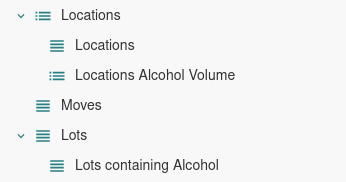In order to clearly separate subjects on the Excise duties on alcohol, tobacco and energy topic (EN/FR):
 A new Materials module
A new Materials module
Materials are Products that have physical Measures (Length, Height, Width, Surface, Volume, Weight).
A lot of materials are tracked (ethanol, gold, carbon dioxide, asbestos, etc.), and so can serve as physical components into multiple products (spirits, jewelry, greenhouse gases, fibre cement products etc.).
For legal obligations, many Materials MUST be tracked in separate Inventory accounts (tobacco, alcohol, energy products, cannabis, narcotics, unhealthy products, products harmful to the environment, etc.).
Economy-wide material flow accounts (EW-MFA), as an international standard, is a legal base statistical accounting framework recording material movement (flow) of physical measures over a given accounting period as they are crossing defined ‘crossing points’ or ‘points of measurement’. EW-MFA cover solid, gaseous, and liquid materials, except for bulk flows of water and air (the general purpose of EW-MFA is to describe the physical interaction of the national economy with the natural environment and the rest of the world economy in terms of flows of materials).
So the new Materials module describe here Tryton’s fundamentals needs for basic double entry materials accounting, following the EW-MFA standard :
- It MUST allow any product marked as
Materialto be associated with specific stock accounting, accounting properties such as taxes, charges, expense or income accounts. - It MUST make it easy to manage these properties using accounting categories, like Account Product and Customs modules help us to do.
The goal at this point should be to convert concepts into rough interface designs: for Getting Real, we start with the interface, the real screens that people are going to use. It begins with what the customer actually experiences and builds Tryton backwards from there. I hope this lets us get the interface right before we get the software wrong. ![]()
- « Materials » SHOULD be Goods Products with a
Materialcheckbox checked - The Materials module SHOULD add the following Materials tab on the Product model
- On peut ajouter une Matière à la liste, en précisant :
- Matière (editable required)
- Seuls les Produits qui ont la case à cocher
Matièreactivée peuvent être liés - Une Matière ne peut pas se contenir elle-même
- Seuls les Produits qui ont la case à cocher
- Quantité (de Matière dans le Produit, editable) : vide = quatité nulle
- Mesure (de référence du Produit, editable) : seule une mesure Produit de même type que l’UDM par défaut de la Matière est sélectionnable parmis:
- Aucune (équivaut à une quantité nulle, sans avoir à supprimer cette matière)
- Quantité (de Produit)
- Longueur (Mesure)
- Largeur
- Hauteur
- Surface (pourqoi n’est-il pas par défaut dans le module Product Measurements ?)
- Volume
- Poids
- UDM (par défaut de la Matière) : modifiable, avec une Unité de même type que l’UDM par défaut de la Matière
- Matière (editable required)
- On peut ajouter une Matière à la liste, en précisant :
- Les menus
Lots containing AlcoholLocations Alcohol Volume- On passera par les liens du Produit (ces derniers sont éventuellement filtrés en standard, par exemple en ne sélectionnant que les produits de type
Matière)
- On passera par les liens du Produit (ces derniers sont éventuellement filtrés en standard, par exemple en ne sélectionnant que les produits de type
- Tout mouvement d’une quantité d’un Produit contenant des Matières, induit le même mouvement pour chaque Matière, selon la quantité listée sur ce Produit.
To be continued…








